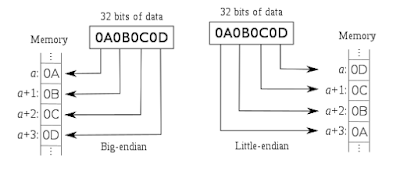How to find a machine is little or big endian?
Introduction
This article explains the methods used to find out whether a machine is big or little endian
Endianness
Endianness is the order of sequencing of bytes in computer memory. It can be either Little endian or Big endian.
How to find it in a Linux machine?
From shell
# little
$ echo -n I | od -to2 | awk 'FNR==1{ print substr($2,6,1)}'
1
# big
$ echo -n I | od -to2 | awk 'FNR==1{ print substr($2,6,1)}'
0
Using tools
bala@IND68FL4H2-L:~/study$ lscpu | grep Endian
Byte Order: Little Endian
If you don't have tools?
If you don't have the above tools, a simple program would do the job#include <stdio.h>int main()
{
int a = 1;
char *c = (char *) &a;
if (*c)
puts("Little indian");
else
puts("Big indian");
}
 |
| Memory view |
When you print the value of pointer *c, if it prints 1 Its a little endian. If it prints 0, its a big endian.
Credits
- https://en.wikipedia.org/wiki/Endianness
- https://unix.stackexchange.com/questions/88934/is-there-a-system-command-in-linux-that-reports-the-endianness


Comments
Post a Comment